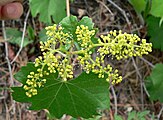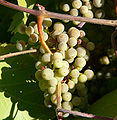Vitis arizonica
| Canyon grape | |
|---|---|

| |
| Canyon grape in Icebox Canyon, Spring Mountains, southern Nevada | |
| Scientific classification | |
| Kingdom: | |
| (unranked): | |
| (unranked): | |
| (unranked): | |
| Order: | |
| Family: | |
| Genus: | |
| Species: | V. arizonica
|
| Binomial name | |
| Vitis arizonica | |
| Synonyms[1] | |
| |
Vitis arizonica, commonly known as Canyon grape, is a North American species of wild grape. It is a deciduous vine.
Distribution
It is found in California (Inyo County), Arizona, Nevada, New Mexico, western Texas, southern Utah, Sonora, Chihuahua, Coahuila, Durango, and Tamaulipas.[1] Within Arizona, Vitis arizonica is found in all counties, except La Paz. [2][3][4]
Morphology
The canyon grape is a vigorously branching vine. Stems are slender, with significant tapering from base to apex. Fully developed leaves resemble a three-lobed heart shape and generally grow to an average of 4 inches long/wide. Leaves exhibit irregular toothed edge. Green flower buds develop in clusters, and small flowers bloom in a whitish green hue. Globe or ovate shaped fruit are typically 1/3-3/8 in diameter; immature fruit is green in color, developing into a deep purple or black. Fruit are clustered on red pedicels.[5]
Gallery
- Vitis arizonica
References
- ^ a b c Species was first published in Amer. Naturalist 2:321. 1868 GRIN (May 23, 2009). "Vitis arizonica information from NPGS/GRIN". Taxonomy for Plants. National Germplasm Resources Laboratory, Beltsville, Maryland: USDA, ARS, National Genetic Resources Program. Retrieved May 12, 2010.
- ^ United States Department of Agriculture plants profile
- ^ Biota of North America Program 2014 county distribution map
- ^ Tropicos, specimen reports for Vitis arizonica Engelm.
- ^ Littlefield, Larry J.; Burns, Pearl M. (2015). Wildflowers of the Northern and Central Mountains of New Mexico: Sangre de Cristo, Jemez, Sandia, and Manzano. Albuquerque: University of New Mexico Press. p. 360. ISBN 9780826355478.
External links





